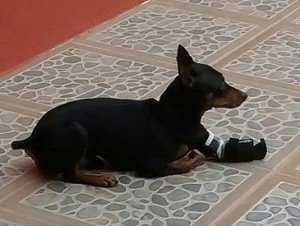Printed Pet Prostheses Project

September 20, 2016
3D printing and scanning have revolutionized the production of prosthetic devices by allowing the design and manufacture of prostheses that can be custom fit for patients. And people aren’t the only ones who have benefitted from the technology. A new volunteer group with a global presence is using 3D printing to provide the same types of devices to pets.
The Computer Aided Pets (CAP) Project is the brainchild of Jim Song, who modeled the group on e-NABLE, which has linked makers with children who are missing hands and arms.
The volunteers at the CAP Project design custom assistive devices using CAD programs. They are matched with people who have pets with those needs based on their location. According to the group’s website:
That way it will be much more convenient for the volunteer to print and build the assistive device. We know that our furry friends cannot speak and thus most likely the first device will need to be modified.
 Although the group is new, designers have already donated a number of different prosthetic designs. Among those designs is the FiGo, a wheelchair originally designed for a French Bulldog that an be used for dogs that are missing their rear legs. It includes 3D-printed joint pieces, along with skate and roller blade bearings, and other parts. A forelimb prosthesis was also created that can be printed in nylon, as well as two designs for a front leg wheelchair.
Although the group is new, designers have already donated a number of different prosthetic designs. Among those designs is the FiGo, a wheelchair originally designed for a French Bulldog that an be used for dogs that are missing their rear legs. It includes 3D-printed joint pieces, along with skate and roller blade bearings, and other parts. A forelimb prosthesis was also created that can be printed in nylon, as well as two designs for a front leg wheelchair.
Another designer created a prosthetic leg for a stork that had necrosis and was losing its feet. There’s a similar design that can be used for a legless eagle.
The group paired its first volunteers and recipients in early September, and launched its website this month as well. For designers interested in joining the group, donating designs, or launching a local chapter, the CAP Project has a Google+ community. You can also find more information about getting involved here.
Currently, the CAP project has chapters in California and North Carolina, as well as in Tokyo, Beijing, Romania and Brazil.
Source: The CAP Project
Subscribe to our FREE magazine, FREE email newsletters or both!
About the Author
Brian Albright is the editorial director of Digital Engineering. Contact him at [email protected].
Follow DE





